This is the ultimate guide to local SEO in 2024.
In this new guide I’ll show you:
- How to rank in the 3-pack
- How to build NAP citations
- How to optimize your Google Business Profile
- Lots more
Let’s get started.

This is the ultimate guide to local SEO in 2024.
In this new guide I’ll show you:
Let’s get started.


In this chapter, we’ll cover the basics of local SEO.
First, you’ll see interesting data that proves that SEO is a must for any local business.
Then, I’ll show you how The Map Pack works… and the best way to track your Map Pack rankings.
Local SEO is the practice of optimizing a business’s visibility in local search results. Key tasks include identifying relevant local keywords, optimizing a business’s Google Business Profile, and creating consistent NAP citations. It is an essential process for businesses focusing on increasing localized traffic, leads, and brand awareness.
I’m not going to throw a bunch of random stats at you.
But I do want to briefly show you a few fascinating statistics to highlight just how huge SEO is for local businesses.
46% of all searches in Google have “local intent” (Search Engine Roundtable).

29% of all Google SERPs contain a local pack in the results (RankRanger).
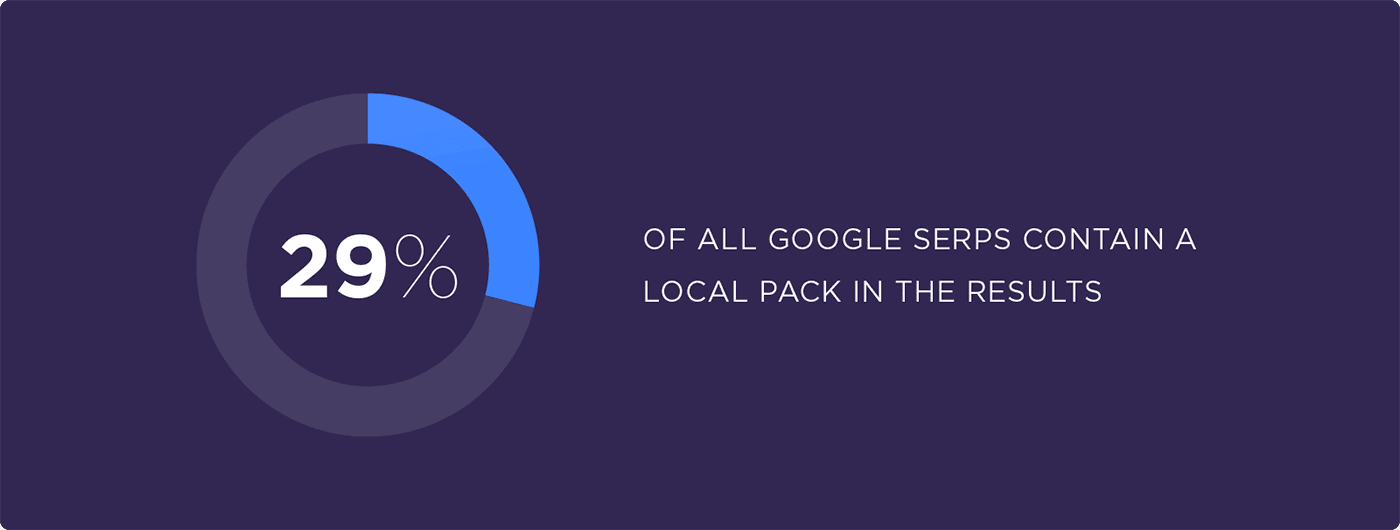
76% of consumers that search for something local on their phone visit a store that day (Google).
So it’s clear that local searches make up a huge chunk of the SEO world. And if you can get your local business in front of these searches, there’s a good chance they’ll be walking through your door a few minutes later.
At a high-level Local SEO works like “normal” Google search.
When someone does a search, Google scans through its index to provide the best results for that person’s query.
What makes Local SEO unique is that Google uses a different set of ranking factors to rank the local search results.
In fact, local SEO has a set of unique ranking signals, including:
Listings, data, and AI-powered reviews — all in one platform.

Chapter 2 is all about The Map Pack.
In this chapter you’ll learn:
So if you want to get a crash course on The Map Pack, you’ll really enjoy this chapter.
The Map Pack (also known as “The Local Pack”) is a set of 3 local business results… with a map of their locations pulled from Google Maps.

For example, when you search for “Barber Boston”, Google has a Map Pack at the very top of the results.

With the “normal” search results underneath it:
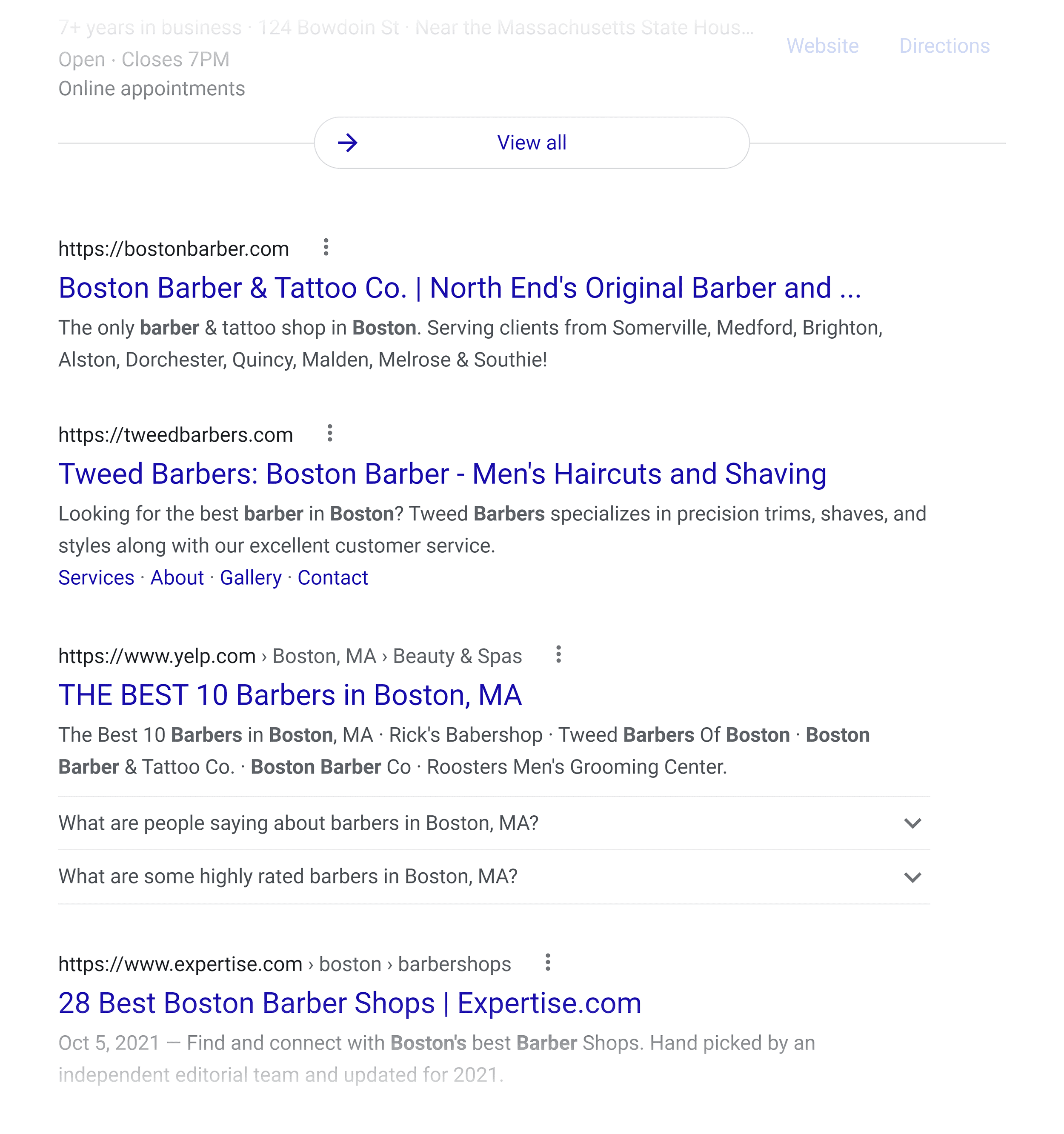
I’ll show you how Google ranks businesses in The Map Pack later in this guide. But for now, just keep in mind that The Map Pack has its own algorithm with its own set of rules.
Sure, some ranking factors (like backlinks) can help you rank in local and traditional organic results.
But others (like NAPs) are pretty much only important for ranking in The Map Pack.
One thing I should point out:
Google doesn’t only show local results for keywords that contain a specific city or state. If Google thinks that your search needs a set of local results, they’ll show it to you… even if the keyword isn’t obviously local.
For example, when I recently searched for “gardener” in NYC, Google gave me a Map Pack.

This is important to keep in mind as you do keyword research for your local business. Yes, you want to optimize for “store + city” keywords.
In many cases, the generic “store” keyword without a location gets more search volume than the “store + city” version.
With that out of the way, let’s see how to track your local SEO rankings.
One of the first steps in any local SEO campaign is to benchmark where you’re at.
Specifically, you want to see where you rank in The Map Pack. And track your Map Pack rankings over time.
Pretty much every rank tracker on the planet has Map Pack tracking.

The issue is that, with local SEO, where you’re searching from is HUGE. In fact, the Map Pack results can be completely different from one mile to the next.
For example, let’s say someone searches for a “coffee shop” on 72nd st and 2nd avenue in NYC.

Those results are going to be super tailored to where that person’s standing.
In fact, that same search performed a few blocks away can bring up a completely different site of Map Pack results (or the same results in a different order).

if you only track your local rankings from a single location (like “New York”), you’re only seeing a small sample of where you actually rank in the real world.
Which is why you want to get super granular with your local rankings. That way, you can see where you rank across your entire city or local area.
I recommend a tool called Local Falcon for this kind of detailed Map tracking.

But there are others, like Local Viking, that do pretty much the same thing.
Anyway…
The first step is to choose your business name (Note: this feed comes directly from Google Maps. So to use this tool, you’ll need a Google Business Profile profile already set up).

Then, choose a keyword you want to check your rankings for.

Finally, choose how specific or broad you want your rank tracking to be.
For example, here’s a 5-mile (8km) rank tracking radius.
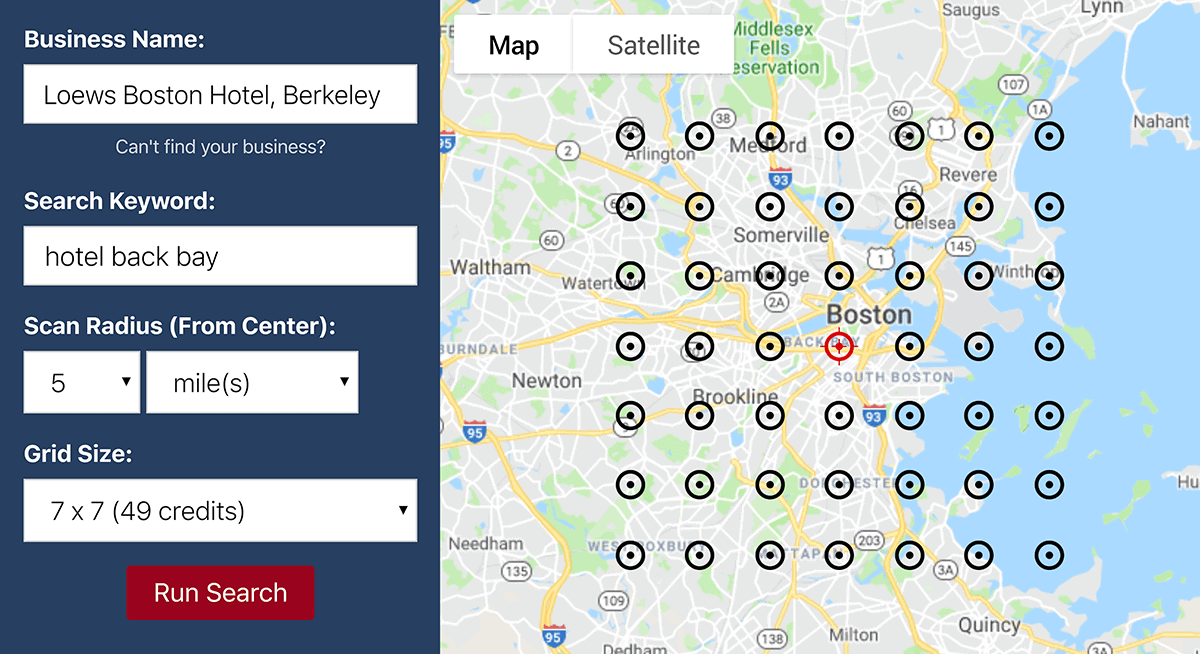
It’s set up with a 7 x 7 grid, which gives you a great idea of where your business ranks across this entire area.
(This grid can go right up to 15 x 15 if you really want to see the edges of where you might rank.)
Then, it’s time to check the rankings.
After the tool does its thing, you end up with a visual interface that shows your rankings for each geographical position:

As you can see, you get a nice interactive map that shows where you rank in lots of different spots throughout the city.
As you can see, rankings are best on the outskirts of the city… and get progressively worse as you go downtown.

This isn’t necessarily a problem. It could be that a competitor has a location that’s more centrally located than your hotel. So for someone doing a mobile search from that location, Google considers the competitor a better fit.
That said, you should use the tool to find spots where you “should” rank well… but don’t.
For example, you can see that this local paving business ranks #1 in the far north of the city… except for one spot.

So in that case, you’d want to click on the result to see who is outranking you:
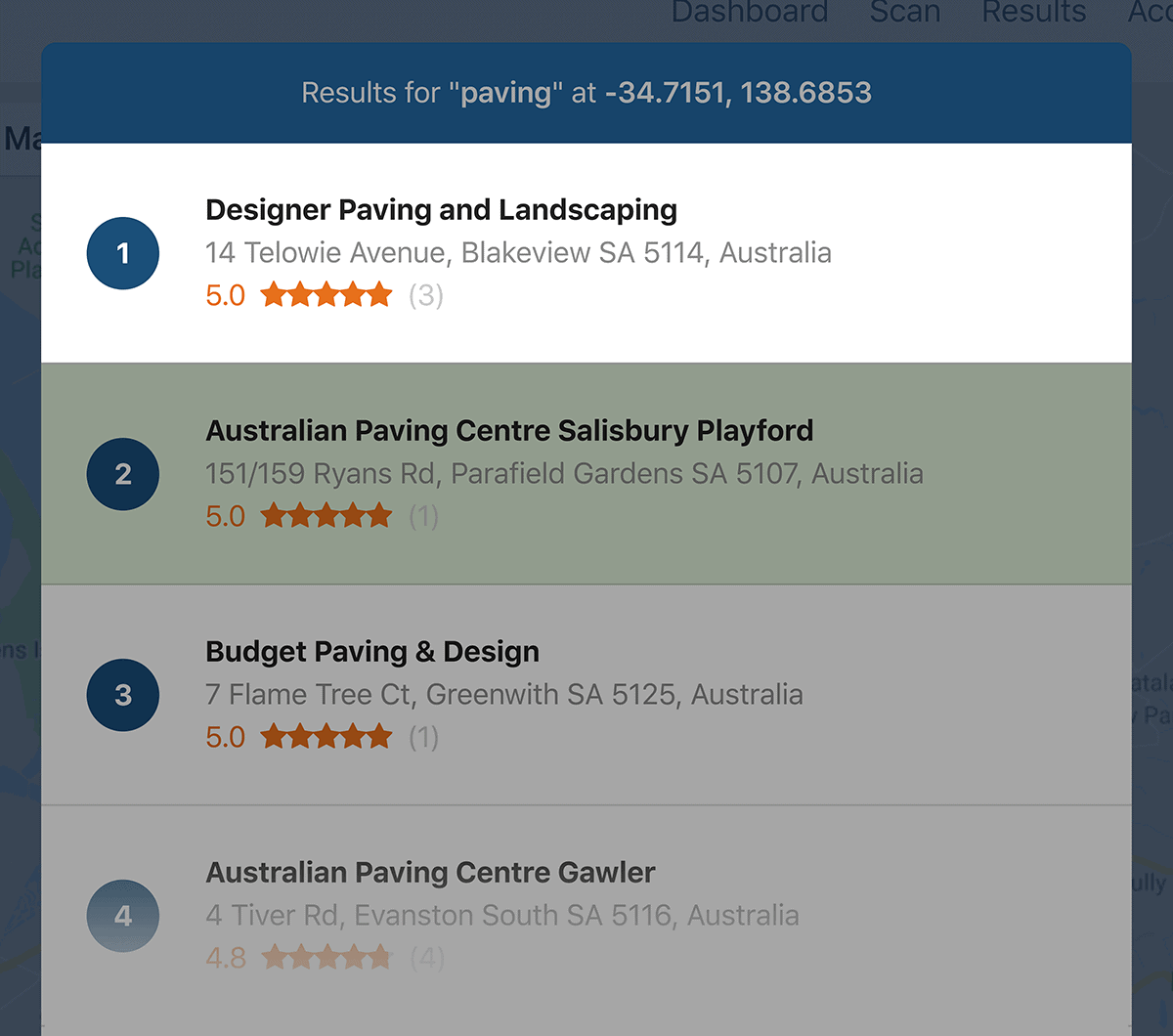
In this case, a competitor is ranking #1.
But if you’re not satisfied with the #2 spot, check out the competitor’s address in their listing. That way, you can cross-check where they are physically located on this map.

And when you put the competitor’s location on the rankings map, you can see why you’re having trouble cracking the #1 spot.

The simple explanation is that this search location is MUCH closer to the competitor. So it makes perfect sense that Google would want to make this competitor the #1 result.
If you’re a local business, The Map Pack is the place to be.
That said:
You don’t want to completely ignore the traditional local results.
Yes, the local organic results usually show up BELOW the local pack.

But don’t let that fool you into thinking that it’s “Map Pack or nothing”. Because most local searches have an insanely strong commercial intent, it’s totally worth ranking in the local SERPs too.
And, unlike Map Pack results, the local results are basically the same for any Google SERP.
So to optimize your site for local organic rankings, you want to use your keyword in your title tag, in your URL… and all the traditional on-page SEO stuff.
Basically, everything covered in this video:
Plus: backlinks. 🙂
Actually, the only unique thing about local organic rankings is how you track them. Remember: “store + city” only make up a fraction of all local searches.
So in addition to “Boston barber”, you also want to track your rankings for keywords like “Barber” and “Barber near me”.
For example, if you wanted to track rankings for “barber near me” for people searching in Boston, you just need to specify the location in your rank tracking tool of choice:

And if you want to get a better idea of where you rank around town, you can track your rankings for that same keyword across lots of different spots.
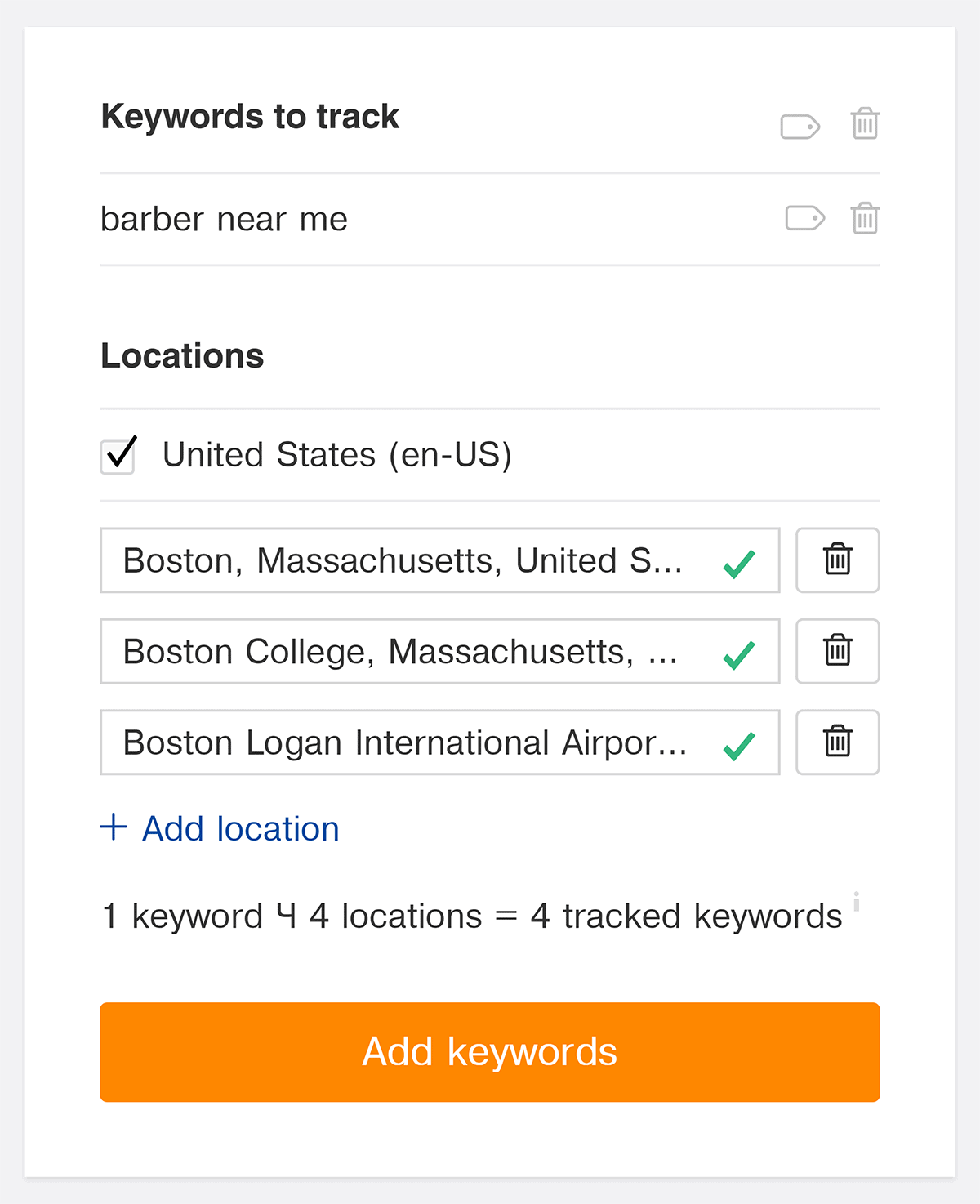

In this chapter, I’m going to show you how to find keywords for local SEO.
Fortunately, local SEO keyword research is basically a “one and done” process.
Unlike a blog, you usually don’t need to keep finding new keywords all the time.
That’s not to say keywords aren’t important for local searches. They definitely are. But in most cases, all you need to get started is a short list of keywords that people use to find your local biz. This highlights the need to undertake a keyword analysis to find relevant and search-worthy words for your target audience.
This works the same as Google Suggest.
Type in a keyword that someone in your area might use to find your business…

…and check out the suggested results.

What’s cool about Yelp is that they sometimes show you keywords that don’t contain the term you typed in.
For example, if you search for “Japanese”, they also suggest “Asian Fusion Food”.

Very cool.
Google Suggest can also work well for local searches.
The only thing to keep in mind here is that the local search has to be something that potential local customers are gonna search for.
For example, if you type in “HVAC”, you get this list of suggestions:

Outside of “near me”, these keywords aren’t a great fit for local SEO.
But when you add a local term, like “HVAC B”, you start to see keywords that you can use.
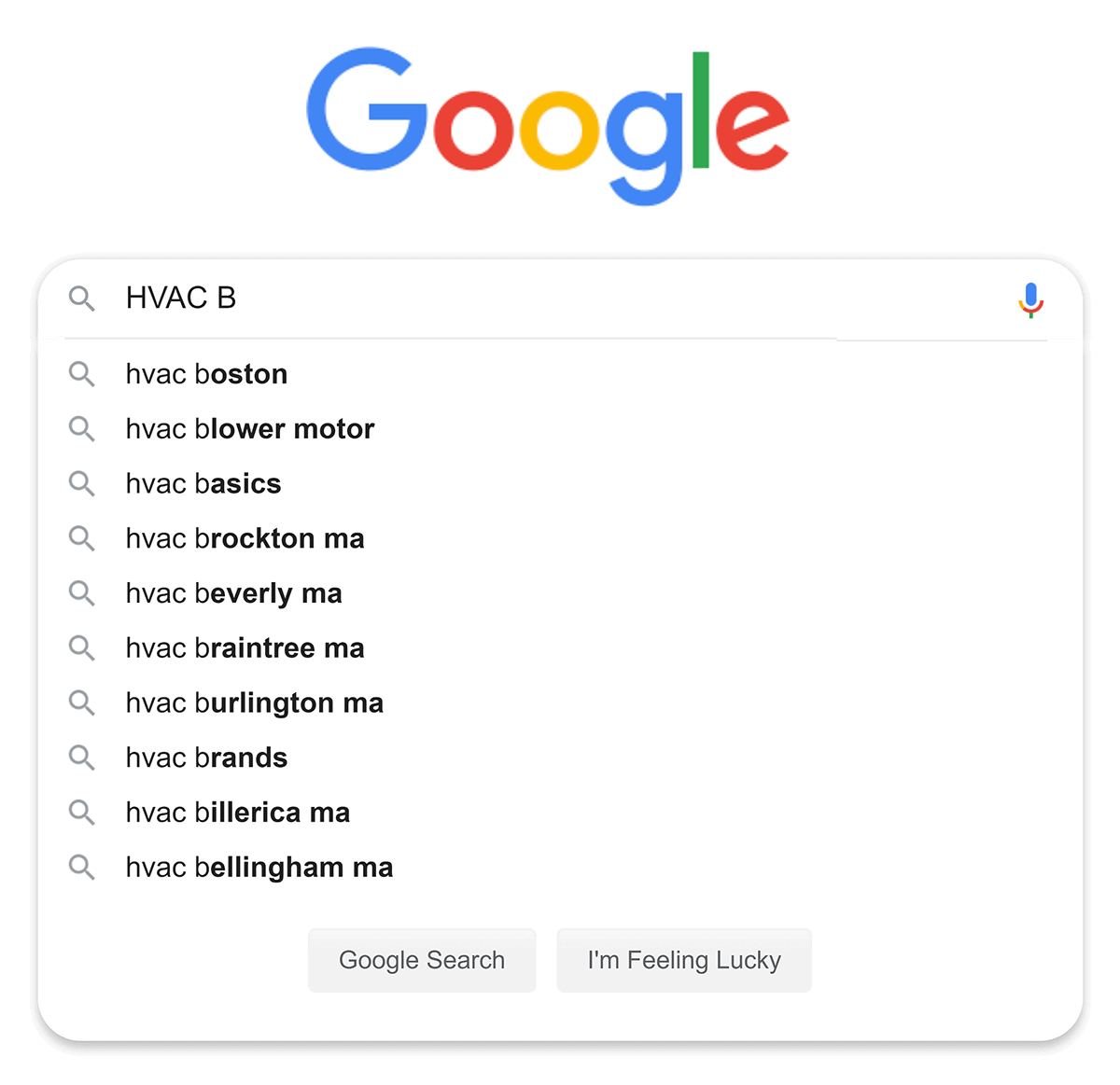
According to Google, 20% of all Google searches done on mobile are now voice searches.

20%!
The main difference between voice and keywords searches is that voice searches tend to be longer and use natural language.
For example, take a local keyword like “gluten free pizza brooklyn”.

Well, that same search done via someone’s voice will probably be more like: “gluten free pizza in brooklyn that’s open right now”.

As far as I know, there aren’t any tools to help you find voice search keywords. But it’s something to keep in mind as you go through this process.
The Google Keyword Planner gives you search volume data for specific geographic areas.

So if you already have a bunch of keywords and want to pick the best of the bunch, this feature is helpful.
But if you’re on the hunt for NEW keywords, I recommend using their “Start With a Website” feature.
Just pop in the homepage URL of one of your competitors:

And Google will suggest a bunch of keywords based on the terms that show up on that page.


Now it’s time to dive into how local SEO in Google actually works.
Specifically, I’m going to briefly cover the most important Google local search ranking factors…
…and a few tips on how you can optimize for them.
Let’s get started.
Few years ago Moz ran its annual “Local Search Ranking Factors Study”.
And they found that the #1 ranking factor for ranking in the map pack was your Google Business Profile.

Your local business website is still important. The content on your page and the links pointing to your site play a role in your Map Pack rankings.
But for your business to rank #1 in The Map Pack, your Google Business Profile needs to be on point.
(Which is why I dedicated an entire chapter of this guide, Chapter 5, to optimizing your GBP.)
Listings, data, and AI-powered reviews — all in one platform.
NAP (Name, Address and Phone number) citations are another key local SEO ranking signal.
NAP citations are places where your name, address and phone number are all listed out.

Why is this important?
Well, Google uses NAPs to confirm that all of your business info is correct. And the more often they see NAP citations for your business, the more confident they are that your address is where you say it is and that your phone number is correct.
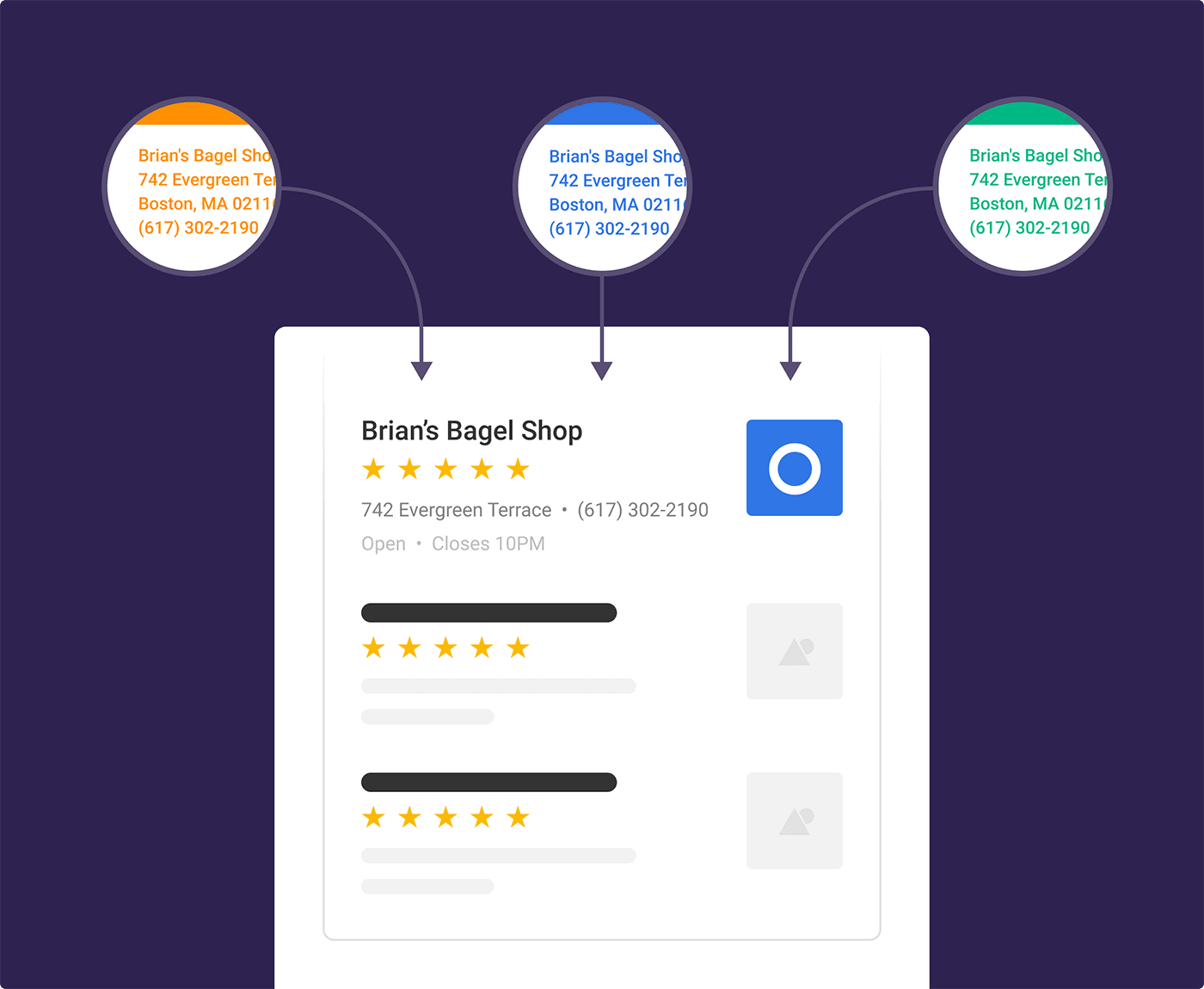
This is why you want to get consistent NAP citations on as many reputable websites as you can.
Moz’s local ranking factors study also found that “Review Signals” played an important role.
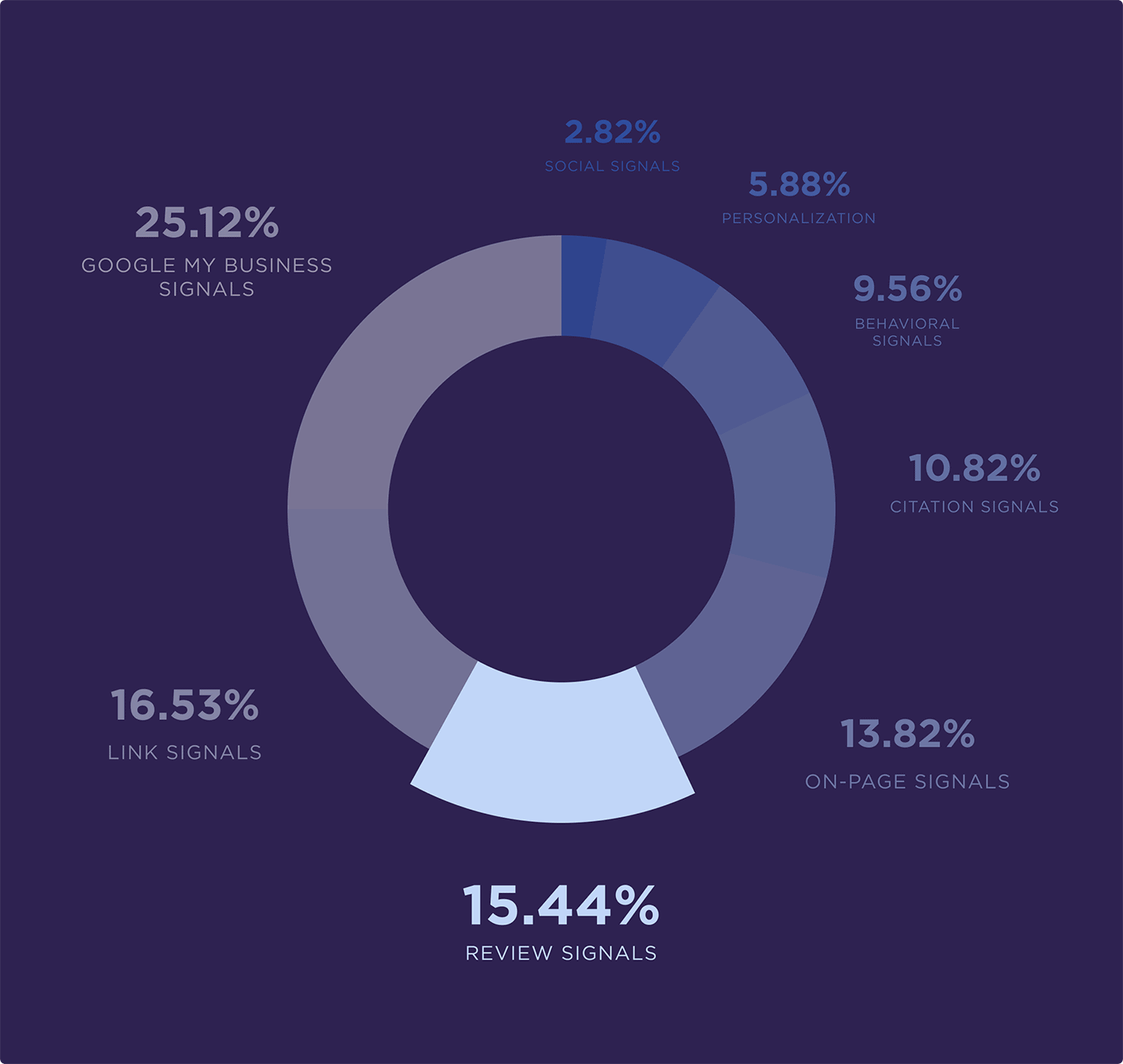
Specifically, they state that negative reviews on your Google Business Profile can hurt you. And that Google probably also uses reviews on 3rd party sites (like Yelp) too.
So yeah, getting positive reviews can help you (assuming that you don’t incentivize folks to leave reviews or ask in bulk). And negative reviews can hurt you.
According to one panelist that participated in the study: “ Reviews (along with an owner’s response) show that consumers trust a business, and trust is a foundational factor in ranking.”.
This means that replying to reviews, even negative ones, can help your local SEO efforts.
With all that said:
Google’s traditional ranking factors still 100% apply to local.
In fact, Google confirmed that your rankings in the organic SERPs impact your local rankings:
"Your position in web results is also a factor, so SEO best practices also apply to local search optimization."
This means: the higher you rank in the organic results, the higher you’ll rank in The Map Pack.
This is why creating content, optimizing your pages and building backlinks is still SUPER important for local SEO rankings. Especially for competitive industries (legal, dentistry, etc).

Now it’s time to optimize your Google Business Profile.
Like I mentioned in the last chapter, claiming your business listing in Google is super important for ranking in the local results.
So if you want to get the most out of your GBP, this chapter is for you.
When it comes to GBP, consistency is HUGE.
Not only should everything you enter into the GBP match your website, but it should also match your NAP citations around the web.

When Google sees that your business info is consistent in your GBP, on your website and 3rd party sites like Yelp, they say: “OK, this business is legit. And their local info all matches up.”

But when your local business has one address listed in their GBP and another on the website, that’s a huge red flag to Google:

So if your business changes its name, physical location or phone number, it’s important that the new data gets updated ASAP. And that includes citations on local business directories.I also recommend double-checking that your business’s address is written out the exact same way on your Google Business Profile and everywhere else it shows up.

Google doesn’t like it when one address says “Avenue” and another version uses “Ave.”.
This kind of thing won’t stop the mailman from delivering your Amazon package. But it’s a confusing signal for Google.
Google gives you a score for how complete your profile is.
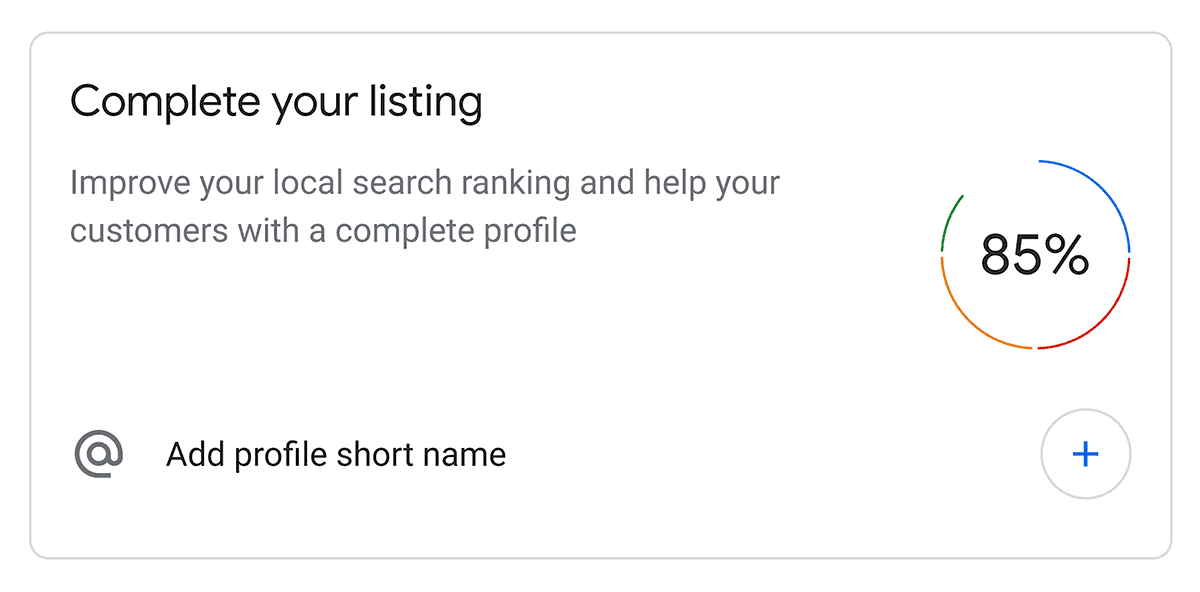
But in my experience, this score is REALLY generous. You can get a really high score just for covering the basics.
So I’d use their score as a baseline. But if you want to rank for competitive keywords, you probably need to go above and beyond.
The main thing I see people miss out on is category selection.
Google will force you to choose a top-level category that describes your business.

And the category you go with has to match a category they already have (you can’t make up your own category).

That said: lots of people forget to add in secondary categories. These secondary categories directly impact the keywords and searches your business can rank for.

While you’re in there, I also recommend filling in the “Services” and “Products” tabs:
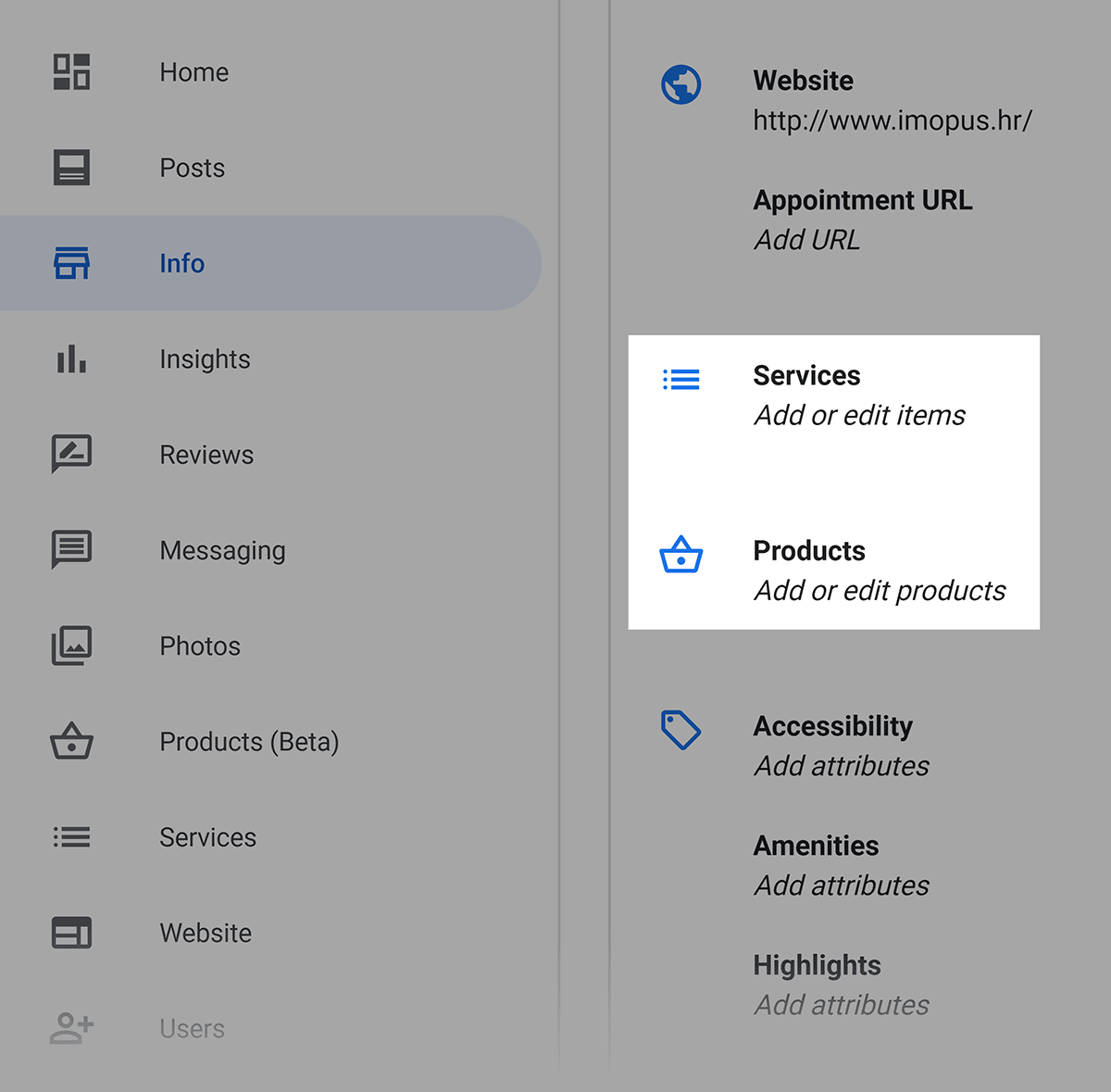
This info tells Google what it is that your business is actually selling. So it’s super important to fill this stuff in.
Double-check that your opening hours, holidays and other basic business info are all accurate and up-to-date.
This kind of thing may not directly impact rankings.
But when someone drives to your restaurant, only to see a “Closed” sign, you can expect a bad review from a hangry person.
So you want it to be second nature that when opening hours change, that change is also made inside Google Business Profile.
As I mentioned back in Chapter 4, reviews are one of Google’s top local ranking signals.
Needless to say, you want as many positive reviews as you can get.
That said:
Whether a review is positive, negative, or in-between, I HIGHLY recommend replying to every single review.
This shows potential customers (and Google) that you care.
Just look at the difference that this reply makes:

If you’re considering visiting India House, the reply takes a lot of the bite out of that negative review.
And you can reply to your reviews inside the Google Business Profile dashboard.

When it comes to getting reviews, there are two things to keep in mind:
And one of the best ways to do both?
Send customers an email with a review link.
There are two ways to generate a review link:
Way #1: Head over to this page and enter your business name.

This will give you the “Place ID” for your business.
Then, add your place ID to this URL:
https://search.google.com/local/writereview?placeid=
So using the example above, the URL would be:
https://search.google.com/local/writereview?placeid=ChIJ-x3_Q8d544kRkvCvAv2dNqY
And when you click on the link, it prompts the user to leave a review.
Way #2: Login to your GBP account and head over to the “Get more reviews” card.

Finally, generate a short URL that you can send to customers.
Very cool.

In this short chapter, I’ll cover a few ways that local businesses can get the most out of their on-site SEO efforts.
So once you’ve optimized your title tags and body copy with the traditional on-page SEO approaches, it’s time to tap into these strategies specifically designed for local small business websites.
You probably already know that you want to write 100% unique content for every page on your site.
So if your business serves Boston and Brookline, you want the content for each page to be completely different.

But what you may not know is that, as long as you avoid duplicate content, you can create these sorts of landing pages for cities that you’re not physically based in.
This obviously won’t help you rank in the Map Pack.
(You need a Google Business Profile for that location for that.)
But you can totally rank in the local organic results for lots of different local keywords. And as long as you serve folks in that area, the traffic will convert well too.
For example, this roofing service has pages optimized around “Brockton” and “Natick”.

The best part? They’re not located in Natick OR Brockton.

Yet they rank in the local SERPs for both of their target keywords.

When it comes to local SEO, Schema markup is more of a “nice to have”.
That said, there’s an entire category of Schema markup for local businesses.
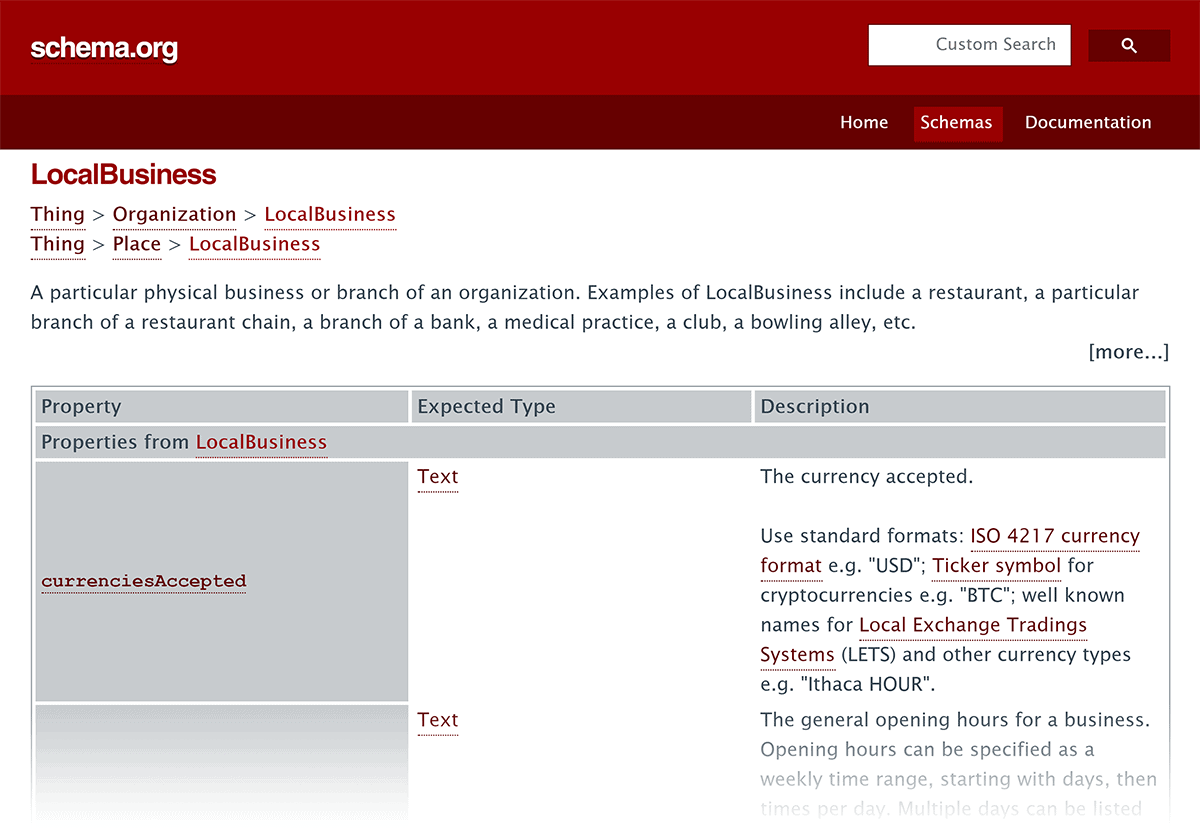
For example, you can use this Schema to markup your address and phone number.
I don’t think Google relies on Schema that much for Map Pack rankings (after all, they have all of this data already in your GBP). But if you’re confident that you can implement it correctly, there’s nothing wrong with using “LocalBusiness” markup on your site.
That said:
One type of Schema that can definitely help is review markup.
Like any SERPs, review stars can turn your boring result into an eye-catching Rich Snippet.

(Note: Google stopped supporting review snippets for “LocalBusiness” and “Organization” schema types. But you can still use review schema for content, tools, recipes or other content on your local business website.)
I picked up this technique from Facebook Ad guru Nicholas Kusmich.
And I’ve found that it works GREAT for local business sites.
The idea here is that you start your title tag off with a strong, benefit-driven statement.

Then, make sure the statement goes beyond Google’s title tag limit (currently 500-600 pixels or 50 characters).
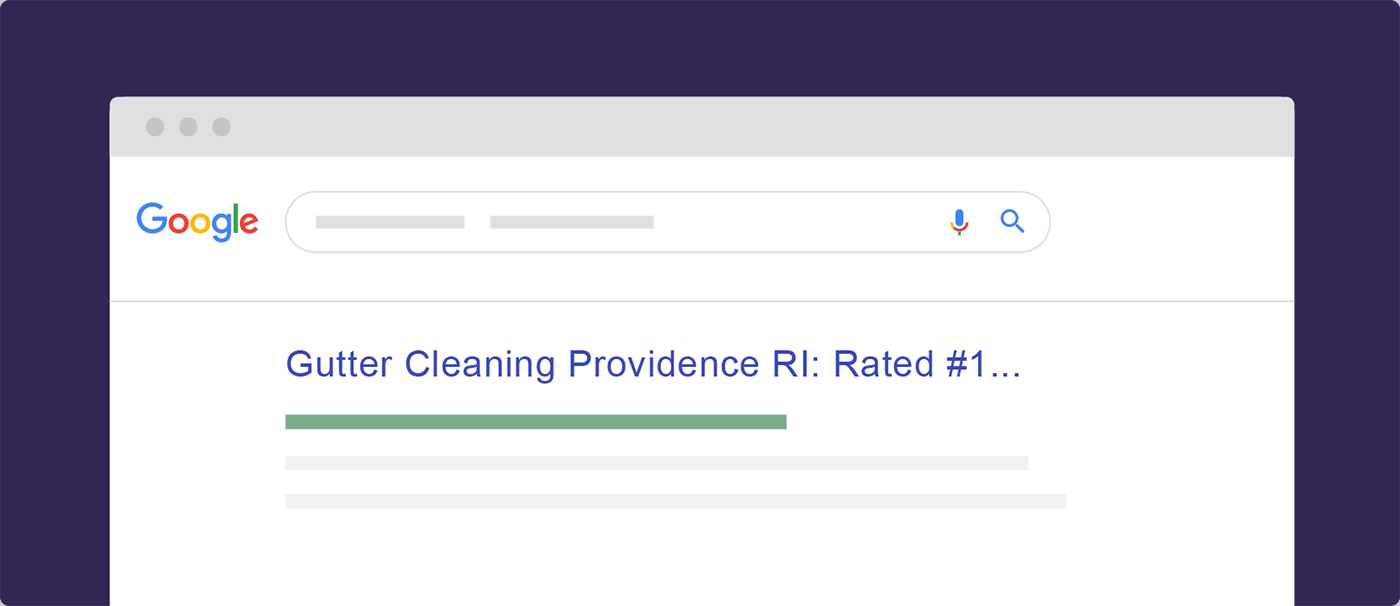
This cutoff creates an open loop that can lead to more clicks.
Backlinko reader Andrew Holland used this technique on his local agency site a while ago.

And he told me that this tactic led to a significant increase in his organic CTR and rankings.

Now it’s time to transition into one of the most challenging parts of local SEO: NAP citations.
NAP citations are like backlinks: they’re super hard to build. But super important too.
And in this chapter, I’ll show you how to build local citations the right way.
You want your NAP data to be 100% consistent everywhere.
On your website.
On your Google Business Profile.
On business directories.
On local listings sites.
Basically: any place that mentions your business online.
There are a million citation tools and services out there. I personally recommend WhiteSpark and Semrush.
Listings, data, and AI-powered reviews — all in one platform.
But like I said, there are quite a few options to choose from.
That said:
No matter what tool or service you use, the most important things you’ll need to have before you start are:
With this information, the tool you use will scour the internet for NAPs. And you’ll get a report like this:
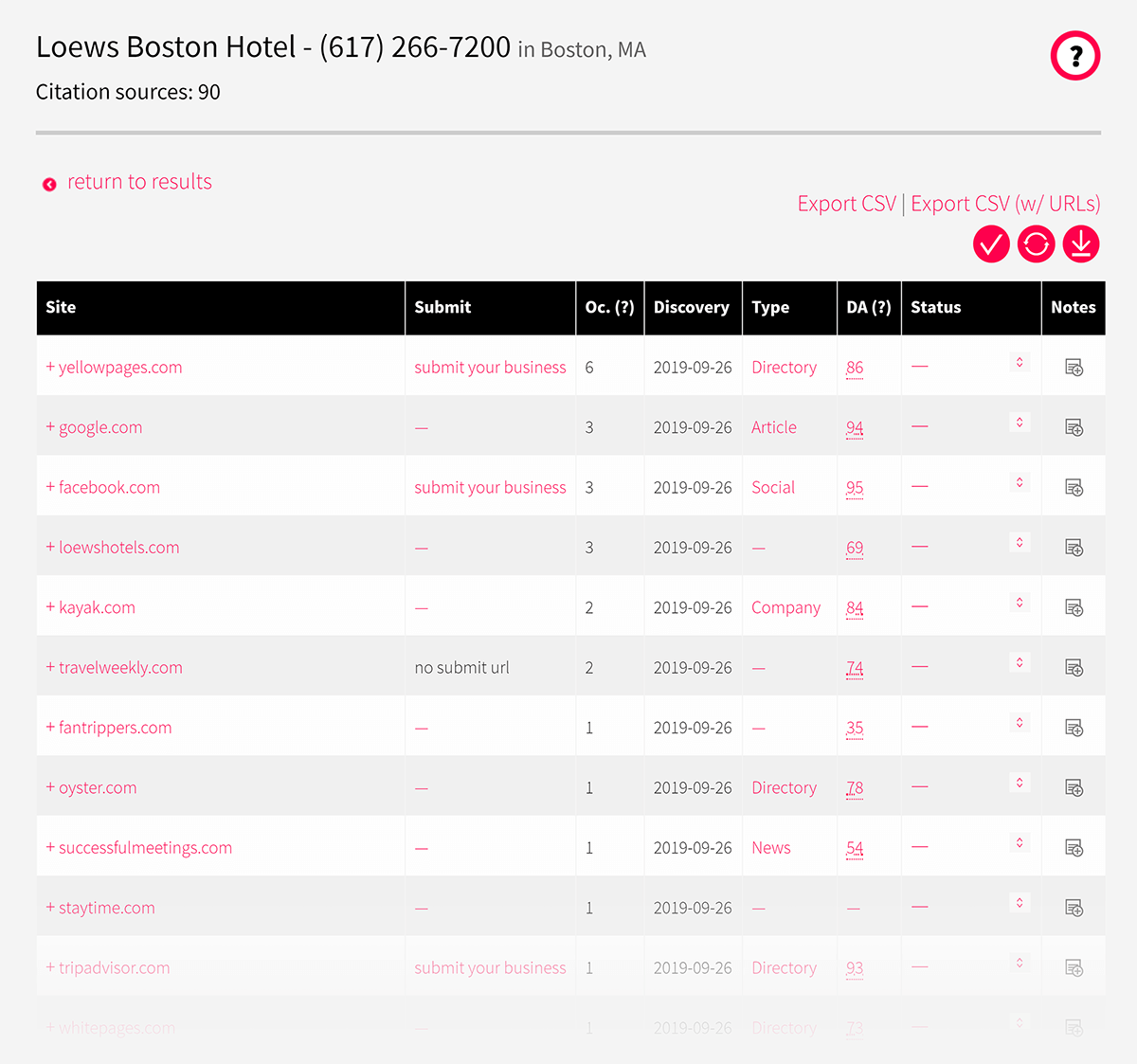
Now that you have a list of citations, you want to find NAP citations that aren’t correct or consistent.

(For older businesses that haven’t done an audit before, you can expect A LOT of citations that need a fix or update.)
So once you have a list of NAP citations that need updating, the next step is to correct as many as you can.
In my experience, incorrect NAPs fall into two different categories:
For the first category, updating these one-by-one is a giant pain. Which is why services like Yext and Bright Local exist.

For citations that need a manual change from someone else, you’ll need to reach out one by one with targeted, friendly outreach emails.
Here’s an example:
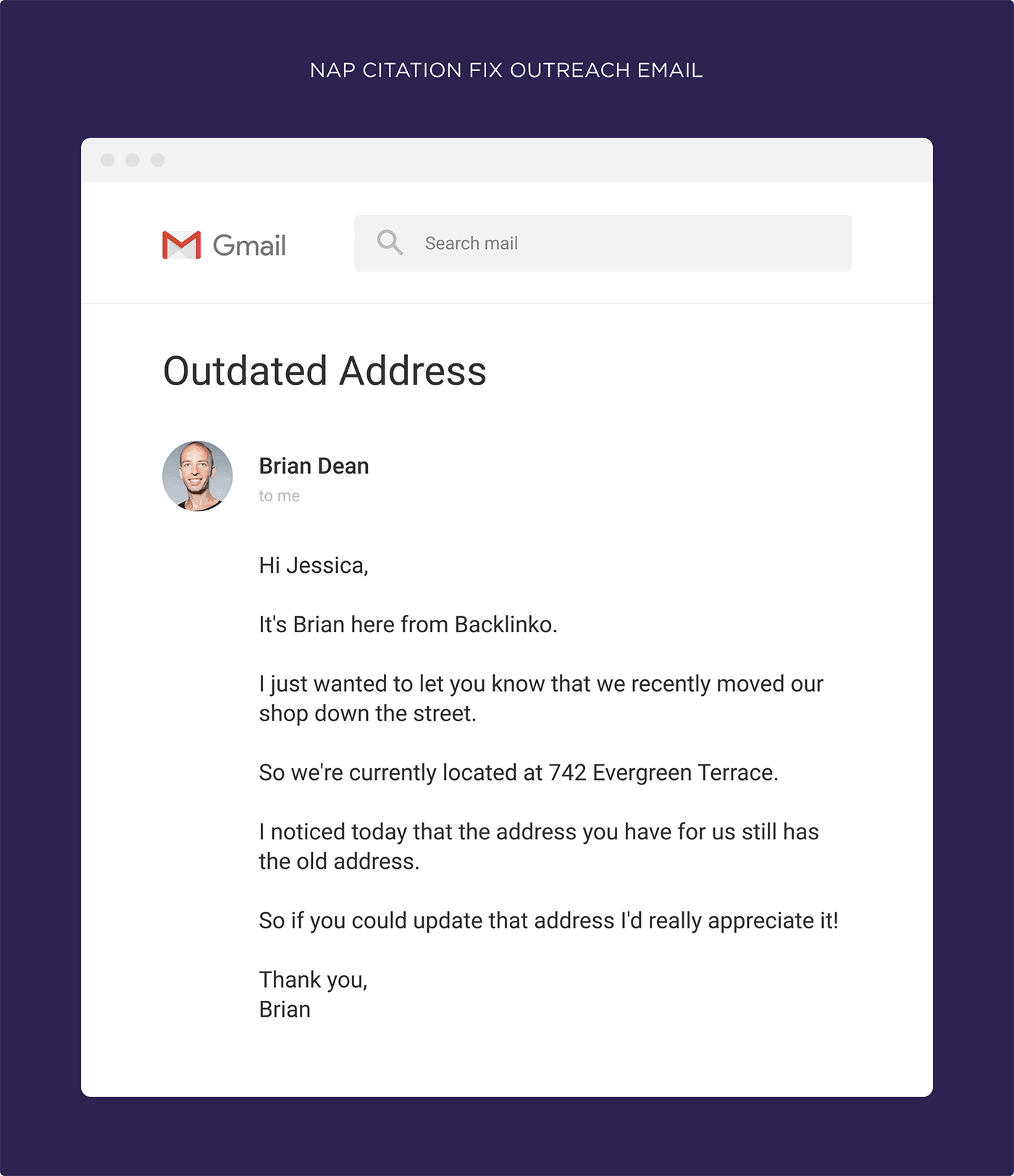
After you’ve built citations at Yelp, FourSquare, Angie’s List, and the other usual suspects, what’s next?
In my experience, your best citation opportunities come from local sites. Local citations are super relevant citations that can give your Map Pack rankings a real boost.
And because you’re reaching out to folks in your local area, your outreach conversion rate is usually going to be insanely high.
Question is:
How do you find these local citations?
I recommend checking out the Backlink Gap feature in Semrush.

As the name suggests, this feature is designed for link building. But, as you’ll see in a minute, it definitely works for citations too.
In fact, you can sometimes “double-dip” and get a link and citation from the same place.
With that, here’s the step-by-step process:
First, take a batch of 2-3 competitors and pop them into the tool along with your website on top:
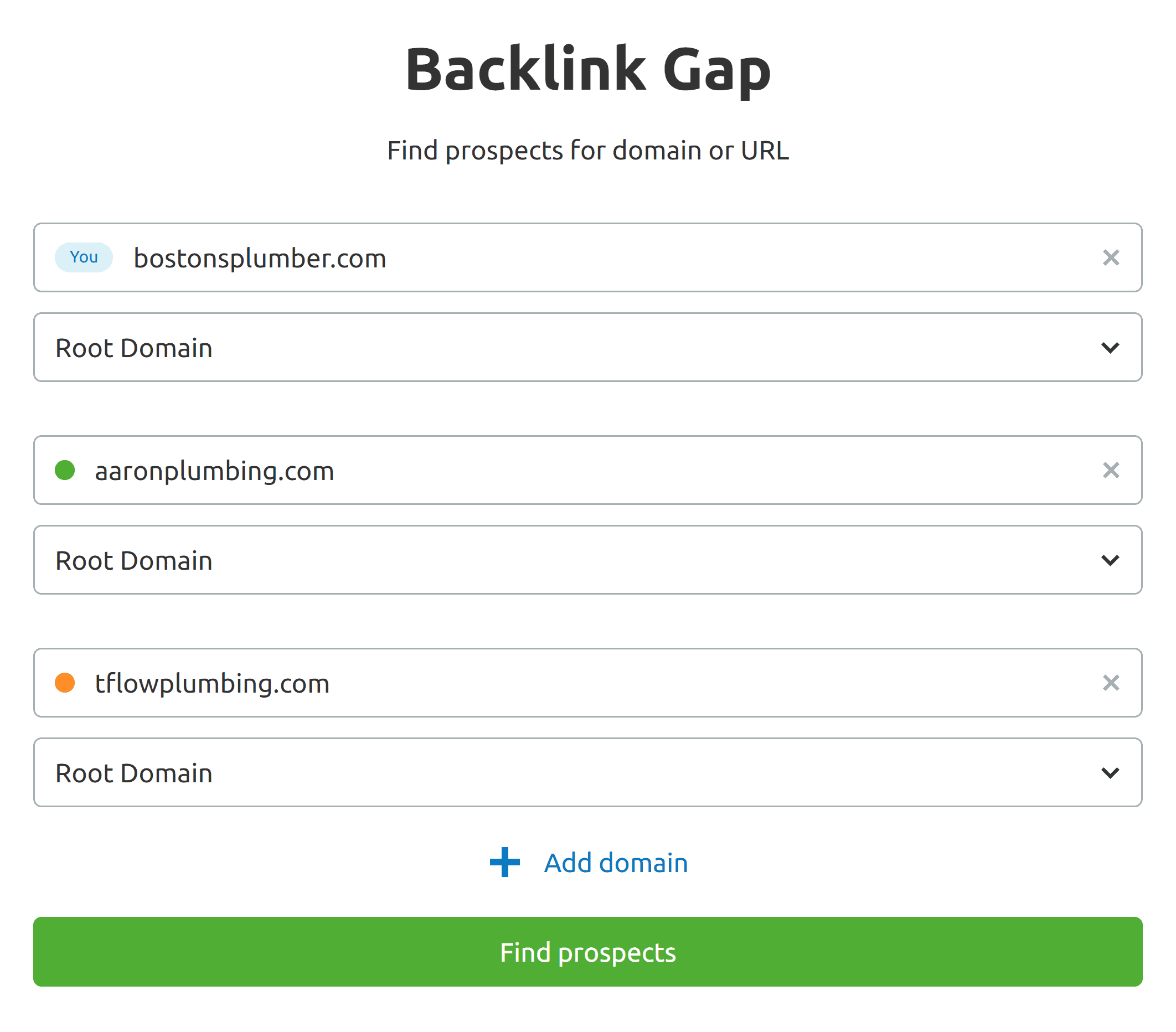
Pro Tip: You don’t always need to use direct competitors here. Any business in your area can work. After all, they’re also building citations from local business directories.
Then, you’ll get a report that lists all the sites that have linked to the competitors you used in step #1.

Finally, sift through the results to find citation opportunities.

Link opportunities:

Or both:

I don’t recommend worrying too much about nofollow links here. Remember: the main goal here is to get your NAP on the page. If you get a link (even a nofollow one) that’s a bonus.
The same tools you use for NAP audits can also be turned against your competitors.
All you need are their NAP details, you’ll get a comprehensive list of all the places they’ve been mentioned online.

In my experience, this approach works better than Link Intersect. With a citation tool, the results don’t necessarily have to have a link to your competitor’s site to show up.
These tools will show you straight up NAP listings, like this:


When it comes to local link building pretty much every link building strategy that works for non-local websites will also work for local dentists, pizza shops and locksmiths.
It gets better:
Because local businesses also have a strong tie to a specific city or state, they also have LOTS of unique backlink opportunities that non-local sites can’t tap into.
And in this chapter, Chapter 8, I’ll cover a handful of powerful local link-building strategies.
Most local businesses have relationships with other businesses in their local area.
Even though you’ll probably need to tap into cold email outreach at some point, I recommend starting off by building links from people that you already know.
So I recommend listing out every:
That you have any sort of relationship with.
Then, look for a specific page on their site where a link to you would make sense.
(This is the step a lot of people overlook.)
For example, this paving contractor has a page that links to some of their favorite distributors.
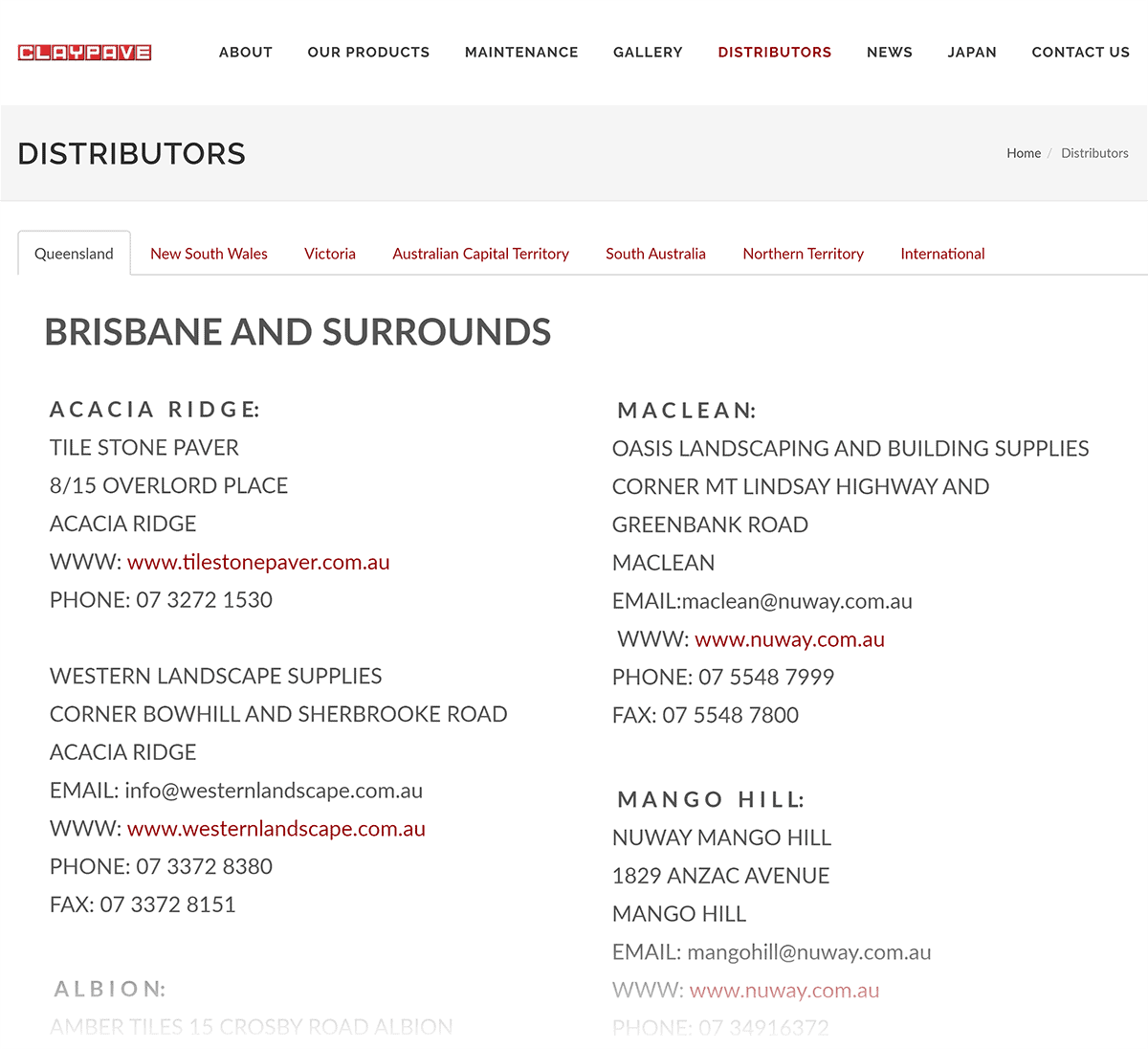
Your local Chamber of Commerce is one of the easiest links you’re ever going to get.
Here’s an example of a Chamber of Commerce backlink:

How you get listed depends on the Chamber. Some require an annual fee. Others make you keep up your membership every year.
Either way, because these links are super relevant, they’re usually worth whatever hoops you need to jump through.
Plus, you almost always get a NAP with your link.

Pro Tip: If you want to get a Chamber of Commerce link that’s actually contextual, consider giving a talk to the local Chamber. If you’ve read this far, you already know more about local SEO than 90% of local businesses out there. So you could give a talk on local SEO… or anything that businesses in your area would want to learn more about.
Here’s an example:

It’s a fact:
Most local events need sponsors.
And if you can sponsor a local event, you’ll usually find yourself with a nice link on the event’s website.
For example, this local non-profit circus has a page that links to their supporters:

And your support doesn’t have to be straight cash. Run a pizza place? Consider donating a stack of large pepperoni pizzas. Are you a printing company? You can offer to print up flyers. You get the idea 🙂
Local newspapers and local news sites are STARVING for stories.
And if you do anything remotely interesting (like an anniversary event or “grand re-opening”), you’ll probably find yourself with a beat reporter covering it.

The only catch is that you need to give the news sites a heads up at least a few days before your event so they can prepare. Plus, you can help them write up the story with background deets before the event even happens.
Now:
If you don’t want to go through the hassle of an event, you can also be a source for local stories.
The best way to find these opportunities?
Twitter.
The two search strings that have worked best for me are:
For example, when you search for “Looking to speak to” + “Boston”, you can see that there are TONS of great PR opportunities.

And now it’s time for the last chapter…

Let’s finish off this guide with a bunch of advanced local SEO tips, strategies and tactics.
None of these tactics will replace good ol’ fashioned NAP building or GBP optimization.
But they can give you a nice little rankings bump.
This is yet another way to find local keywords to optimize around.
For example, when you type in “Cleaners”, it gives you a handful of suggestions:

Including a bunch of super-specific terms PERFECT to create landing pages around:

This is a great way to really emphasize to Google that you’re located in a specific place.
All you need to do is find your business in Google Maps.

Then, hit the little dropdown menu in the top left corner of the screen. And click “Share or embed map”.

This will give you an embed code.
Finally, embed that map on your site’s contact or directions page.

In my experience, this single tip can HELP a lot with local organic rankings.
All you need to do is make sure your local-focused keyword shows up at the very top of your page in a headline.
Something like this:

And I recommend wrapping that title in an H1 tag.
That said:
This is more for UX signals than straight-up on-page SEO.
Why?
When a local searcher lands on your page, they need to know that you serve their area within 2 seconds.
And when they see a headline like this, they’re probably going to go back to the search results to find a business that’s 100% focused on their city.

On the other hand, a headline like this makes someone say: “Great. They serve Boston. I’m definitely in the right place.”

This is an old-school SEO approach that still works really well for local businesses.
All you need to do is optimize your homepage title tag around 2-3 keywords.
For example, this local business’s homepage is optimized around “kitchen remodeling san diego” and “bathroom remodeling san diego”.

And they rank in the top 3 for both:
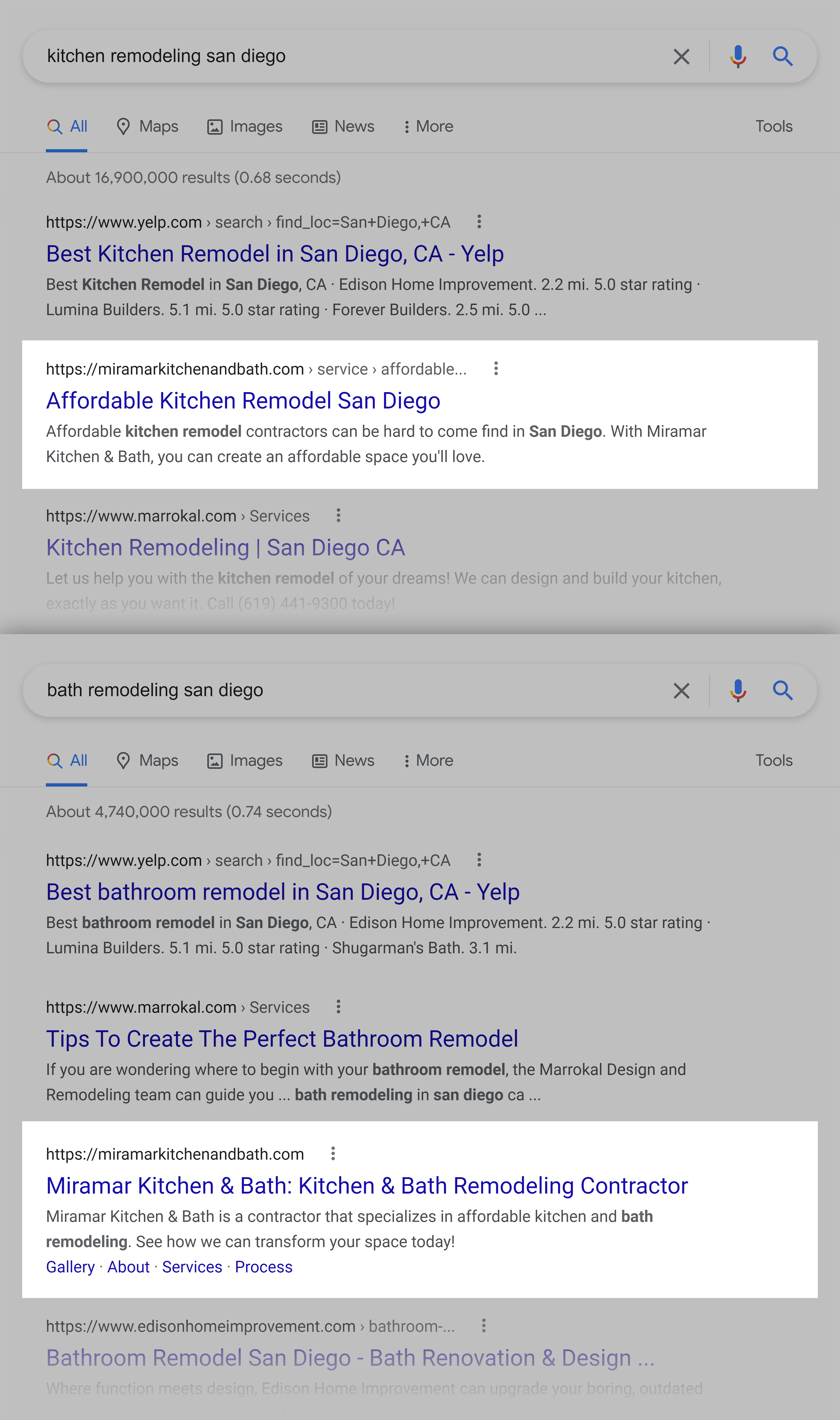
This works in the local world because most local businesses get VERY few links to internal pages.
From analyzing link profiles of the local sites I’ve worked with, I notice that 90%+ of a local site’s backlinks tend to point to their homepage.
This means: you need to squeeze the most value out of your homepage. And optimizing it around several different related keywords is one of the best ways to do that.
It’s no secret that your description is a GREAT way to improve your organic CTR.
Unfortunately, I see a lot of local businesses with keyword-stuffed descriptions like this:

#facepalm
Instead, I recommend going with this formula:

Pro Tip: Use Google Ads to find compelling description copy. After all, this copy is proven to get clicks (otherwise, they wouldn’t use that copy in their ads). So you can’t go wrong by using some of their copy in your description.
For example, when I search for “hotel new york”, I notice that Google ads use the terms like “save”, “free upgrade” and “price guarantee”.

These terms would be PERFECT to use in your page’s description.

I want to give a shout out to Backlinko readers Joshua Ballard and Andrew Holland for helping me put this guide together.
Read next: 26 Small Business Marketing Software & Tools You Need by Dmitry Dragilev
Now I’d like to turn it over to you:
Which technique from this guide do you want to try first?
Are you going to find keywords with Thumbtack suggest?
Or maybe you want to optimize your local description.
Either way, let me know by leaving a comment below right now.